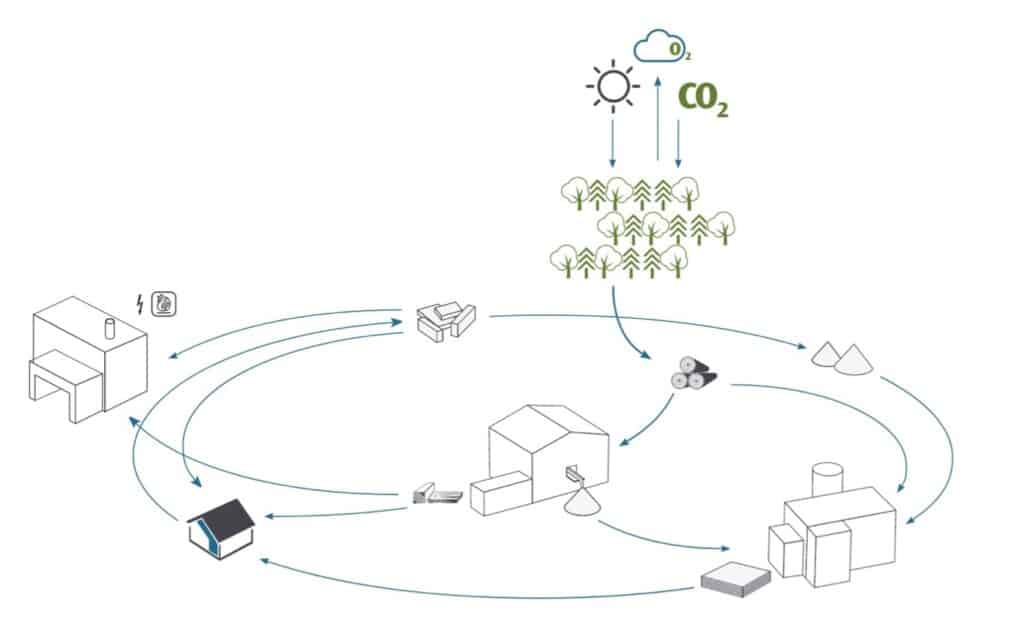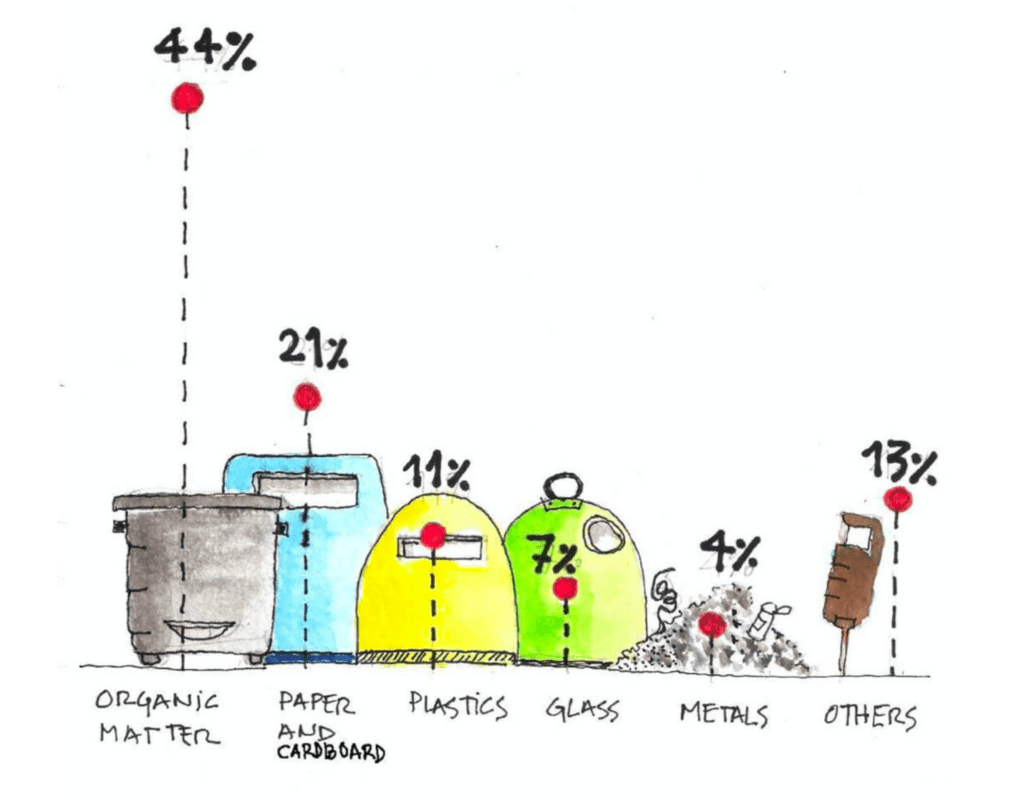Modular homes have several eco-friendly advantages over site-built homes, so if you are thinking about building but are concerned about the environmental impact, then a modular home could be the right fit for you. “The future of real state is modular” ensures a Forbes article, while assuring that modular homes are eco-friendlier than “stick-built” (on-site built) houses [1]. However, even though it is generally accepted that modular homes are environmentally friendlier than standard constructions, not every modular home choice will be harmless to the environment. What defines an Eco-friendly modular home often carries some confusion since this concept is broadly used nowadays. It is possible though, to evaluate the green aspect of a construction by estimating the ecological footprint of the modular home. To do so we will need to look beyond construction and analyse the whole life cycle of the modular home:
- House construction
- Operation and Maintenance
- Demolition or Deconstruction
When contemplating the Ecological Footprint of the house construction there is an enormous amount of factors that need to be considered. To understand if modular homes are better for the environment we need to regard the necessary energy, raw materials and wastage produced by every product, process or activity.
What defines an Eco-Friendly Modular Home
The “eco-friendly”, “green” or “environmentally friendly” tags are often subjective and confusing. All of them describe a quality of a product that minimizes the impact on the environment [2]. However, this quality is relative to the current situation and always based on a comparison, what was considered environmentally friendly some years ago might not qualify for this tag today. In order to avoid confusion and regulate these ratings, the Federal Trade Commission (FTC) details the Green Guides requirements [3] to ensure companies follow the updated regulations to achieve its certificates and allow consumers to know that particular product is officially recognized as eco-friendly.
Certificates can be issued to a material, component, an appliance or even to the whole house; certificates such as LEED, Passive House, Energy Star or Living Building Challenge can be helpful for consumers to understand the qualities and offerings of the home they are building. Sometimes though, these certificates only cater to a small part of the construction, so some of the biggest modular home companies in the United States such as Method Homes, Plant Prefab or Blu Homes offer a variety of these certifications to ensure that their homes are build up to those specific standards. What defines an Environmentally Friendly Modular Home today is a collection of properties that ensure that the overall impact of that house is respectful to the environment according to today’s standards. To encompass this set of properties and get a global understanding of the modular home environmental impact we can relate to the Ecological Footprint.
The ecological footprint of the modular home
The Ecological Footprint (EF) is a tool designed by Mathis Wackernagel that allows us to visualize the environmental impact of a given construction, showing the amount of land required to build, maintain and demolish that particular house. It takes into consideration all the resources and services that the house will consume and all the waste and greenhouse gases that it will produce. The Ecological Footprint represents the environmental consequences of the house taking into consideration its whole life-cycle [4].
House Construction
The ecological footprint of the house construction in the modular process is generally lower than on-site construction. However, this statement is not necessarily true in all situations since an on-site home can be built consciously reducing the environmental impact by using nearby and ecologic materials, reducing the transportation needs and recycling material wastage. And a modular home could on the other hand, not keep an environment consciousness in mind and disregard facts as using environmentally damaging materials, require long distance transportations and not reutilizing material wastage.
The material selectionis a key aspect in the ecological footprint of construction but can as well be a bit tricky to define which materials are environmentally friendlier because that can vary on each situation. For example, wood is as a general rule, a better choice than steel and concrete, since the use of wood products is part of an ongoing natural life cycle. However, this is the case only when wood is obtained from responsibly managed forests and the transportation distance from where the tree is cut isn’t excessive.

Fig.1. Sustainable Forestry Carbon Cycle
Which leads us to the next important aspect which is transportation. According to the United States Environmental protection Agency (EPA), the transportation industry is responsible for the largest portion (29%) of the total U.S. Green House Gas Emissions in 2019 [5]. Modular constructions centralize the whole construction process in one location which highly reduces the transportation necessities of construction. The materials required for construction can be delivered in bulk to the manufacturing location and stored to be used in a number of different houses [6], while on-site construction requires the delivery to the construction site of only the required materials used in that particular house. Definitely, the transportation of the completed modules from the manufacturing location to the site has a big environmental impact but in general this is overly compensated by the benefits obtained from the centralization of construction. In order to ensure a lessen environmental impact, the distance of the module delivery should be reduced and the manufacturing company providing the construction of the house should not be placed at a significantly long distance from the site where the house will be placed.
The last aspect relating to the environmental impact of house construction is one of the biggest pollutants during the construction process: materialwastage. The construction sector alone is responsible for the production of 40% of the waste generated in each country [7]. Every piece of material leftover or residual material becomes waste and waste is one of the main pollutants in the construction industry. Modular homes though, are built in a controlled environment under an industrialized process which manage to reduce the wastage. Since the construction of each home is carried on the same location, materials can be reused and the wastages of one home can be recycled into the next one [8].
Operation and Maintenance
Approximately 90% of the energetic demand of the building occurs while the house is being operational [9]. Modular homes aren’t necessarily environmentally friendlier than on-site built homes when it comes to operations, and that often includes those tag as ecological modular homes. For a modular home to be environmentally friendly while operational, we need to pay attention to its certifications. For example the LEED certification, “the most widely used green building rating system in the world” [10] has different tags to mark the quality and achievement in green building. While it offers a Building Operations and Maintenance plaque (LEED O+M) not all buildings that are LEED certified cover this particular area, and while being certified as green construction might perform poorly once operational [11].
In order to reduce the environmental impact of the house during operations it is important to design the installations, services and appliances up to energy efficiency standards, since an energy efficient house reduces the energy demand considerably. There is a number of modular home companies offering energy efficient homes and some such as Method Homes [12]and Plant Prefab[13]even go beyond this tag to offer Net-Zero homes, which energy demand to energy consumption are in balance and therefore equal to zero. According to the National Grid, a net zero home balances the amount of greenhouse gas produced and the amount removed from the atmosphere [14] which therefore ensures quite an environmentally friendly operational phase. To ensure a lesser ecological footprint during the operational phase it is important as well to educate the user into the ecologic impact of the its actions, such as assessing them into energy, water and material consumption, waste generation and recycling potential [11].
Usually the maintenance required in modular homes is minimal thanks to the higher quality materials and a good manufacturing process. Since each module is constructed entirely in a factory like environment, the comfortability of the building location together with a lack of weather disturbances ensure a better construction quality and an outstanding manufacturing process in comparison to traditional on-site construction. Moreover, the fact that the modules need to be transported to the site where they will be assembled, reinforces the need for good quality materials and a resistant structure. Which won’t only ensure the resistance of the modules until the construction site but will as well ensure a good quality construction that will require minimal maintenance. The less maintenance needed, the less environmental damage.
Demolition or Deconstruction
Material wastageis one of the biggest pollutants, and this aspect is especially noticeable during demolition and deconstruction where waste management plays a big role. Construction has usually managed wastage in a linear process: building with new materials and throwing away when not needed. Today’s environmental consciousness however, leads us towards a circular waste management were reusing and recycling become key. In order to ensure a circular waste management and therefore certify an environmentally friendly demolition phase, we need to design a house that is built using high quality products and that it enables an easy deconstruction allowing us to separate, reuse and reconfigure the components [15].
Modular homes as a general rule, due to the nature of their construction process offer us this qualities, which ensure a circular waste management, making them environmentally friendlier than on-site build homes when it comes to demolition and deconstruction. According to Modscape, modular prefabrication is the most sustainable way to build since when compared to traditional construction, it reduces around 80% of waste [16]. Since modular homes are formed by a series of prefabricated modules assembled on site, the connections between elements are usually made by dry techniques, which make deconstruction easier and allow reusing the building components, reducing then the material wastage [17]. When connections between elements are done with dry techniques the separation of different materials is easier and therefore the recycling of each material becomes simpler.

Fig.2. Percentage of Municipal Solid Waste (MSW) components on the construction Site
Modular homes are better for the environment
While designing a new home we have the chance to reduce the environmental impact, cutting the energy demands while using the design keeping in mind the feasibility of future possible repairs and maintenance of the house itself. The construction industry is responsible for a 23% of the air pollution [19] and Modular building seems to be offering a much needed solution to it. Some of the main reasons while in general, modular homes are better for the environment than on-site built homes are:
- Material selection: A number of modular home companies use high quality materials and often lean towards those that are environmentally friendly.
- Material transportation: The nature of the modular home construction process allows bulk transportation of materials to the construction location (factory-like setting), reducing the environmental impact of material transportation in comparison with traditional building techniques.
- Construction waste: Since modular construction takes place in a factory-like environment the leftover materials resulting from the construction of one house can be reused in the next one, reducing enormously the material waste in comparison to on-site built construction.
- Energy Efficiency: Some modular home companies offer energy efficient homes that ensure a low environmental impact during the operations phase.
- Maintenance: Modular homes usually warranty a better quality construction that will ensure a minimal maintenance in the future.
- Demolition Waste: Since modular homes are prefabricated and most of its components are generally assembled through dry techniques, the deconstruction, reuse and recycling of each component is viable, reducing the amount of demolition wastage.
While we can state that in general Modular construction is better for the environment than on-site construction, to ensure an eco-friendly house we should lean towards modular home companies who offer and specialize in certified green houses.
References
- Sanchez, C. (Feb 8, 2021) The Future of Real Estate is Modular Forbes https://www.forbes.com/sites/theyec/2021/02/08/the-future-of-real-estate-is-modular/?sh=5b47747373ec
- Webb, A. (May 27, 2021) Explaining Green, Eco-friendly and Environmentally friendly MCR Safety https://www.mcrsafety.com/blog/environmentally-friendly
- Environmental Claims: Summary of the Green Guides Federal Trade Commission (FTC) Protecting America’s Consumers https://www.ftc.gov/tips-advice/business-center/guidance/environmental-claims-summary-green-guides
- S. Bastianoni, A. Galli, V. Niccolucci and R. M. Pulselli The ecological footprint of building construction The Sustainable City IV: Urban Regeneration and Sustainability WIT Transactions on Ecology and the Environment, Vol 93 (2006) WIT Press www.witpress.com
- (2021) Inventory of U.S. Greenhouse Gas Emissions and Sinks: 1990–2019 United States Environmental Protection Agency (EPA) https://www.epa.gov/ghgemissions/inventory-us-greenhouse-gas-emissions-and-sinks-1990-2019
- Blaney Flietner, M. Modular Homes go Greener Bob Vilahttps://www.bobvila.com/articles/454-modular-homes-go-greener/
- Silva Urbano, D. S., (2015) Environmental footprint of modular building solution using LCA approach Instituto Superior Técnico, Universidade de Lisboa, Lisboa (Portugal).
- Monroy Bobadilla, A. (Dec 13 2018) Impacto Ambiental durante el proceso de Construcción Colegio Mexicano de Ingenieros Civiles A.C. https://cmicac.com/2018/12/13/impacto-ambiental-durante-el-proceso-de-construccion/
- Martínez Rocamora, A., Solís-Guzmán, J. and Marrero, M. (September 2017). Ecological Footprint of the use and maintenance phase of buildings: Maintenance tasks and final results. Energy and Buildings. 155. 10.1016/j.enbuild.2017.09.038.
- This is LEED Leadership in Energy & Environmental Design (LEED) http://leed.usgbc.org/leed.html
- Paola Pomè, A., Tagliaro C. and Ciaramella G. (2021). A proposal for Measuring In-Use Buildings’ Impact through the Ecological Footprint Approach Sustainability 2021, 13, 355 https://doi.org/10.3390/su13010355
- Sustainability . Responsible Design + Construction Method Homes® https://www.methodhomes.net/sustainable-design
- Frequently Asked Questions – Sustainability. Does Plant do LEED certification, net zero or passive homes? Plant Prefab, Inc. https://www.plantprefab.com/faq
- What is net zero? National Grid https://www.nationalgrid.com/stories/energy-explained/what-is-net-zero
- Dobrowolska, K. (August 31 2021) Construction and Demolition Management Archdesk https://archdesk.com/blog/construction-and-demolition-waste-management/
- Sustainable Design Principles Modscape Holdings Pty Ltd. https://www.modscape.com.au/homes/sustainability/#1622532259407-b85fcd9f-d978
- Bertino, G., Kisser, J., Zeilinger, J., Langergraber, G., Fischer, T. and Österreicher, D. Fundamentals of Building Deconstruction as a Circular Economy Strategy for the Reuse of Construction Materials. Applied Sciences. (January 20 2021), 11, 939. https://doi.org/10.3390/ app11030939
- (May 13, 2021) How can we improve the negative impact construction has on the environment? Procure Partnerships Frameworkhttps://procurepartnerships.co.uk/how-can-we-improve-the-negative-impact-construction-has-on-the-environment/
Fig.1. Howe, J., Fernholz, K., Malmsheimer R. and Bowyer, J. (2015) Building with wood = Proactive climate protection Dovetail Partners, Inc. https://www.dovetailinc.org/report_pdfs/2015/building_with_wood.pdf
Fig.2. Solis Guzman, J. Marrero, M., 2018 Ecological Footprint Assessment of Building Construction Bentham Books, Seville (Spain).



